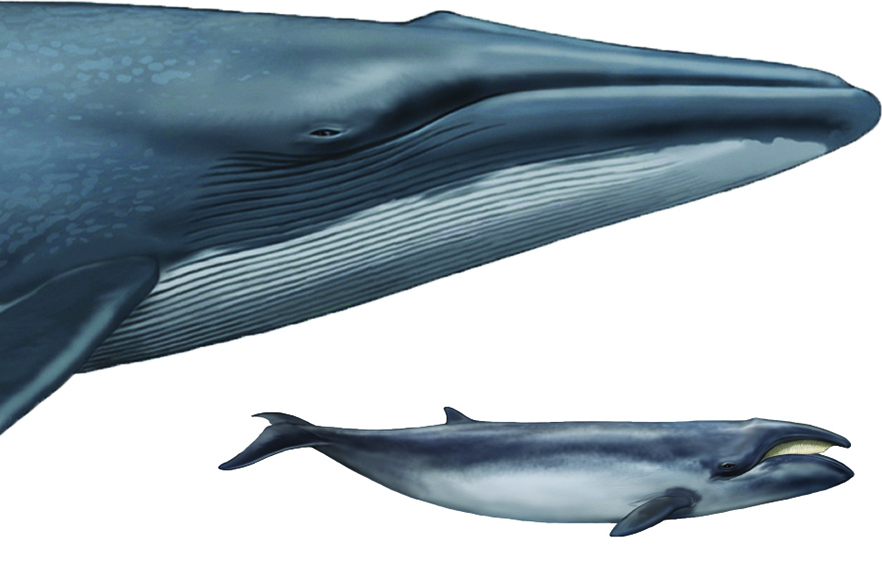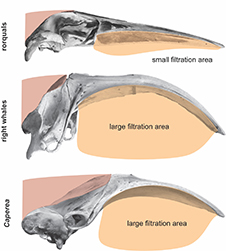
The smallest baleen whale, Caperea marginata, compared to the largest: the blue whale, Balaenoptera musculus. Credit: Carl Buell.
Researchers have finally settled a decades-long dispute about the evolutionary origins of the pygmy right whale.
The smallest of the living baleen whales, it's tank-like skeleton is unique, and its ecology and behaviour remain virtually unknown.
Because it is so unusual, the evolutionary relationships of the pygmy right whale (Caperea marginata) have long been a bone of contention.
In a study that solves the debate, just published in Marine Mammal Science, an international group of researchers sequenced the complete genome of Caperea, combining their findings with morphology and palaeontology.

Comparative figure image: The skull of Caperea resembles that of right whales because both need to accommodate long baleen plates for skim feeding. Their similarities are the result of convergent evolution. Credit: Felix Marx
Co-author Dr Felix Marx, curator of marine mammals at the Museum of New Zealand Te Papa Tongarewa explains the skull shape of the pygmy right whale seems to be adapted for skim-feeding, where a whale will swim at the water's surface with its mouth open to food.
“This is very similar to the larger true right whale, leading some scientists to believe the two whales are closely related, hence their similar names. However, others believe the pygmy right whale is more closely related to species like the blue whale, which take big gulps of water to collect food instead of skimming,” he says.
He was pleased to be able to exploit the power of genomics to elucidate the history of life.
“After 150 years of anatomical orthodoxy and decades of dispute, genomics now shows beyond reasonable doubt that Caperea is a distinct lineage and not related to right whales.
“Like river dolphins and sperm whales, Caperea is the sole guardian of a unique piece of evolutionary heritage. It's not just another weird right whale – it truly is the last survivor of an otherwise lost family that once played a much bigger role in Earth's history,” he says.
Co-lead author Dr Kieren Mitchell, of Manaaki Whenua – Landcare Research, says new genetic information often prompts scientists to reconsider why different animals appear more similar or different to each other.
"When DNA and anatomy seem to be at odds about the relationship between species, usually that means there's an even deeper and more interesting story to be discovered about their evolution,” he says.
Co-author Dr Nic Rawlence, Otago Palaeogenetics Laboratory Director, describes Caperea as a “wonderful case of convergent evolution”, which occurs when two unrelated species end up appearing more and more alike as they adapt to similar selective pressures.
“Caperea has historically been aligned with right whales because they look the same due to similar feeding strategies, when, in fact, it's probable that Caperea is the last surviving member of an ancient group of whales called cetotheres,” he says.
Co-lead author Dr Ludo Dutoit, of Otago's Department of Zoology, says now its position in the family tree of whales has been confirmed, researchers can start to explore what the Caperea lineage looks like, and what kind of past events were significant in driving its evolution.
Dr Marx agrees, adding that Caperea may be another example of how being 'unusual' helped save a lineage from extinction.
“River dolphins likely survived the demise of their marine relatives because they invaded freshwater habitats; sperm whales persisted when their toothed relatives disappeared because they were deep-diving suction specialists; and Caperea survived because it adapted to be a skim filter feeder, when most of its relatives presumably didn't.”
Publication details
Convergent evolution of skim feeding in baleen whales
Ludovic Dutoit, Kieren J. Mitchell, Nicolas Dussex, Catherine M. Kemper, Petter Larsson, Love Dalén, Nicolas J. Rawlence, Felix G. Marx
Marine Mammal Science
https://doi.org/10.1111/mms.13047
For more information, please contact
Dr Nic Rawlence
Otago Palaeogenetics Laboratory Director
University of Otago
Email nic.rawlence@otago.ac.nz
Dr Felix Marx
Curator Vertebrates
Museum of New Zealand Te Papa Tongarewa
Email felix.marx@tepapa.govt.nz
Ellie Rowley
Communications Adviser
University of Otago
Mob +64 21 278 8200
Email ellie.rowley@otago.ac.nz
